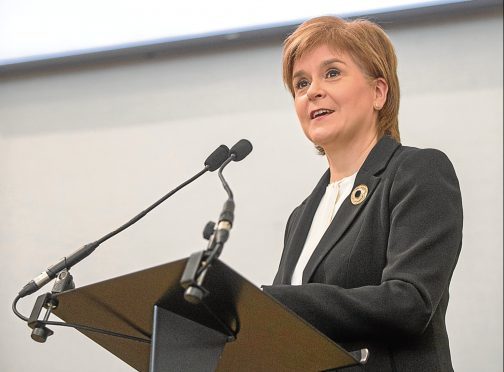Before we leave 2017 forever, let’s recall a strange moment – a speech that summed up Scotland’s predicament in 2018 but which has been wiped from our collective memory.
Nicola Sturgeon got to the podium in the Drawing Room at Bute House and said Scotland would have a second independence referendum in order to have a say on Brexit.
Indyref2 was not just a threat or a strategic tool – on March 13 it was real.
It’s a forgotten event. The SNP do not refer to the referendum, never officially cancelled it and have never explained how it was going to happen. More pertinently, Scotland currently has no leverage over Brexit at all.
It is an interesting speech for the assumptions it makes.
The First Minister says: “As a result of the Brexit vote we face a future, not just outside the EU, but also outside the world’s biggest single market.” That is still true but it does look like Theresa May, by absorbing insults while never revealing her hand, is navigating us somewhere none of us can predict.
Ms Sturgeon goes on: “In addition, the collapse of the Labour Party means that we face a prolonged period of uninterrupted and unchecked Conservative government at Westminster. Some predict that the Tories could be in power now at Westminster until 2030 or beyond.”
The FM got that one wrong. Labour fought to a respectable vote in the 2017 general election, and are on the rise in Scotland. The election saw the SNP’s huge majorities cut to narrow margins, with Labour often in second place.
We are no longer told that only independence can guarantee a left-of-centre government.
“The Prime Minister herself has been clear that the Brexit process will see the UK Government reserve for itself powers in areas that are currently wholly devolved to the Scottish Parliament.”
It is hard to tell if that’s still on the cards. The UK Government insists more powers will come to Holyrood, but is vague on the detail.
Ms Sturgeon goes on: “We argued that the UK should either stay in the single market or seek an outcome that would allow Scotland to do so.”
This remains the Scottish Government position, though we’re no clearer on how Scotland would have a special deal. The Scottish Government was quick to claim the same rights as Northern Ireland but that too has been forgotten, as nobody is sure on the detail of EU/UK deal on the Irish border.
“If the UK leaves the EU without Scotland indicating beforehand – or at least within a short time after it – that we want a different relationship with Europe, we could face a lengthy period outside not just the EU but also the single market. That could make the task of negotiating a different future much more difficult.”
This remains true – Brexit will bring Scotland out of the EU. If it then became independent and voted to rejoin the EU, it would have to apply as an outsider.
Then comes the punchline: “I will now take the steps necessary to make sure that Scotland will have a choice at the end of this process.
“So I can confirm today that next week I will seek the authority of the Scottish Parliament to agree with the UK Government the details of a section 30 order – the procedure that will enable the Scottish Parliament to legislate for an independence referendum.”
“That choice should be offered between the autumn of next year, 2018, and the spring of 2019.”
There it was, a second referendum in a six-month window of time – and yet there will be no vote this coming autumn, or next spring; and this is where we fall into the abyss of forgetfulness – the Scottish parliament did approve a motion that there should be another referendum, but no talks were held with the UK Government.
Instead Mrs May called an election, the SNP lost 21 seats, and the nation was willed to forget the second vote had ever been planned.
Ms Sturgeon ends the speech: “If I ruled out a referendum, I would be deciding – completely unilaterally – that Scotland will follow the UK to a hard Brexit come-what-may, no matter how damaging to our economy and our society it turns out to be.”
Which appears to be exactly what she has done. The speech’s points about Brexit’s damage to Scotland are correct. Scotland is a bystander in what feels like an exercise in English nationalism. Yet we have no leverage in the matter. If not an independence referendum, doesn’t the same case justify a second referendum on Brexit?
